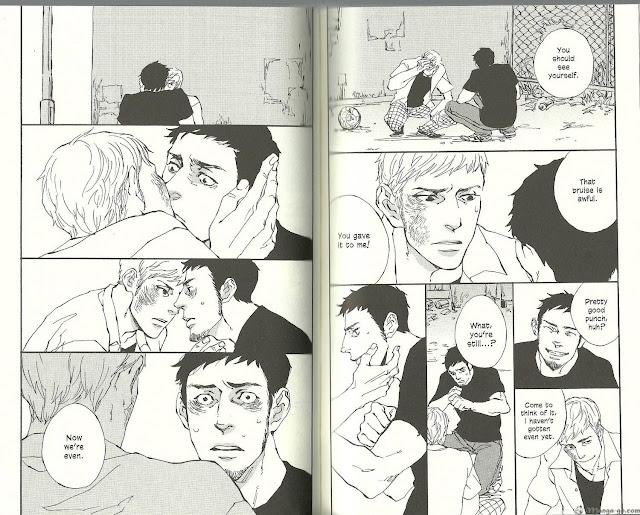Favourite Mangakas: est em on centaur lovers, an udon fetish and the Spanish allure
Any yaoi obsessed person and/or serious fan of alternative
manga will eventually hear of est em somehow or other. Needless to say, est em
(de-capitalised as preferred by the author) is merely a pen moniker. Her real
name is Maki Satoh.
Occupying the recluses of heavily European-inspired art in
Japanese manga, her characters are uncompromisingly distinctive and instantly
recognisable.
To start off, let’s take a look at her BL works since she did,
after all, debut in that genre. When it comes to the men she draws, she has
perfected the essence of sensual virility. Through rugged strokes and an
astute eye for chiseled complexions, her illustrations expertly capture the
male form at its most beautiful and lyrical without sacrificing an ounce of
masculinity.
In fact, her drawing and narration style is so different
from typical BL manga that newbies to her work wonder if she’s actually not Japanese. That is how foreign her stories
feel. In an interview
with Jocelyne Allen of the blog Brain Vs. Book, she explains why this is so.
“People who read a lot of manga draw manga-like manga,
people who read novels, I think they probably draw things that have a lot of
monologues or dialogue. My biggest influence is the Western films I’ve been
going to see since junior high school, mostly American films, but also French
films, Italian films, Russian films.”
Expanding on this aesthetic aspect, she also highlights
her fascination with the physical male form.
“When I was in junior high, high
school, I loved Michelangelo, and there was a period where I copied him
obsessively. I just adored the human body that he drew. I really love drawing
the male body, the muscles. Simply in terms of the lines, there’s a tremendous
amount that interests me.”
The Battle of Cascina (1504) by Michelangelo
David (1501 -1504) by Michelangelo
In another
interview with Jocelyne, she talks about how she goes to Spain every year;
her enthrallment, almost devotion, to the country clearly inspires the plots
she writes of. (She can even speak basic Spanish, akin to the level of a “ten
year old”, as she puts it) Her interest in this vibrant and passionate culture
began with flamenco.
Flamenco art (Credits to ryoung-art and NonPrints)
“When I was a university student, I used to watch Antonio
Gedas’s films. Films like Blood Wedding and Carmen. I watched all those films
with famous flamenco dancers in them.” Eventually, she fell in love with the
world of bullfighting and this is the central theme of two of her mangas, Red Blinds The Foolish and Golondrina.
Golondrina
(P.s. It’s a fascinating interview by the way, she talks
about her interest in various cultures and cities and how it translates into
her works. One of my favourite parts was when she described her trip to
Ukraine, and how she met up with a fan’s friends who lived there. But the most
intriguing part was when she spoke about her views on digitalising her works
and making them available online. She has a sort of “new age” thinking, a more
modern and liberal mind-set when it comes to distributing and translating
Japanese manga to reach out to a global audience. It’s pretty eye-opening –
even if you don’t plan on getting into est em, the interview is a great read
just for that reason.)
Une Histoire d'Un Amateur de Friandises
In stories like Une
Histoire d'Un Amateur de Friandises, the plotline seems to possess neither
start nor end; instead flowing ambiguously like watching a motion picture of
fragmented memories. She manages to weave in a little mystery, a delicious
risqué factor (that comes from suggestive flirtations and the suave demeanour that
preludes the main character), while glorifying chocolate in a coevally classy
and carnal way. Totally makes me want to take a trip to pa-ree and rendezvous
amongst the finest choco boutiques.
Udon no Hito
Her non-BL works still keep that aura of adult-like
sophistication, with the females exhibiting a keen and mature self-awareness on top of whatever personality they may possess. Udon no Hito is innocent, light-hearted and whimsical in its
concept. It follows the adorable budding romance between a 35 year old
cafeteria lady and a college arts student 14 years her junior. (Age gaps… I dig
them oh so much.) Definitely a more conventional, but no less enjoyable, story
that showcases est em’s development in versatility, and willingness to explore
varied cultural settings and social dynamics.
But above all, what I enjoy the most is her rustic yet stylish take on the slice-of-life genre. Ippo gives us a glimpse into the daily routine of a young and established shoemaker. The modest storyline belies the wealth of research that must have gone into it, and the rich art transports the reader into a realm of fantasy, despite the plot being based on reality.
Ippo
But above all, what I enjoy the most is her rustic yet stylish take on the slice-of-life genre. Ippo gives us a glimpse into the daily routine of a young and established shoemaker. The modest storyline belies the wealth of research that must have gone into it, and the rich art transports the reader into a realm of fantasy, despite the plot being based on reality.
Through interview articles
and the like, I came to appreciate est em’s works more. She’s a very cultured,
creative and open-minded soul, and these qualities influence her mangas. Her narrative style conveys a mellowness and panache that transcends the
norms of not just yaoi, but manga in general.
She is now focusing on non-BL stories, which I’m excited to
see. I think she’ll get even more popular through the years, as she continues
to flesh out and cement her unique approach to manga.

Written by Faelan




































No Comment to " Favourite Mangakas: est em on centaur lovers, an udon fetish and the Spanish allure "